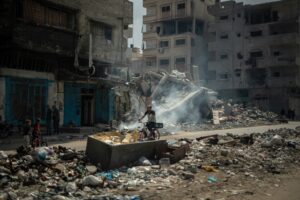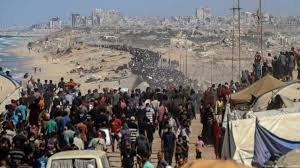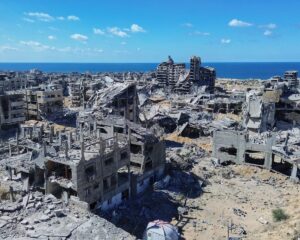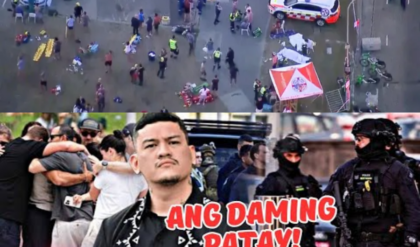The cessation of hostilities between Israel and Hamas, marked by a ceasefire on October 10, brought a flicker of hope to tens of thousands of displaced Palestinians. These families, carrying their meager belongings after repeated evacuations, began their arduous journey back to their homes in northern Gaza, clinging to the hope of rebuilding their lives and seeing the conflict permanently end.
However, for countless returnees, this homecoming has become a devastating shock, replacing hope with profound desolation. They have returned not to damaged communities, but to vast expanses of utter ruin—neighborhoods painstakingly built over decades now entirely leveled. The scale of the destruction has left many describing the scene with harrowing hyperbole, comparing the damage to the aftermath of a catastrophic, almost “nuclear-like” explosion.

The Shock of Unrecognizable Neighborhoods
For residents like Suhair al-Absi, a 50-year-old mother of seven, the reality was a crushing blow. Returning to her neighborhood in Sheikh Radwan, located in the northern part of Gaza City, she found herself completely disoriented.
“I had hoped to find my house still standing, but the reality was the exact opposite. I couldn’t even recognize the area anymore,” al-Absi recounted. Her description painted a picture of indiscriminate obliteration: “Not a single concrete pillar is intact; even the stones were crushed into tiny fragments.”
The extent of the damage was personally shocking. “The most staggering thing to me is the level of devastation across the entire neighborhood. I have never seen anything like it. It feels as if this place was just hit by a nuclear bomb,” she continued, struggling to articulate the sense of totality in the destruction.
Witnessing the Siege: Robotic Demolitions and Retreat
Al-Absi’s family had initially resisted evacuation warnings from the Israeli Defence Forces (IDF) in September, even as the IDF prepared for a ground offensive to root out remaining Hamas cells in the city. She bore witness to the terrifying process of house-to-house destruction.
She observed Israeli “robots”—remotely controlled, heavily armored vehicles packed with explosives—detonating homes nearby. The IDF utilized these unconventional methods to minimize troop casualties while systematically advancing through urban areas.
“We decided to leave only when Israeli tanks closed in on our neighborhood, choosing to evacuate south to protect my family,” al-Absi explained. Now, seeing her home reduced to a pile of rubble, the emotional toll is immense. “Now, seeing my house become a pile of bricks, all I could do was collapse and weep. All the memories and milestones our family had for 40 years are now gone.”

The Imperative to Stay: Living on the Rubble
Despite the bleak outlook, a primal desire to remain on their ancestral ground persists. Around Sheikh Radwan, some families have started erecting makeshift shelters within the ruins, using salvaged fabrics and blankets for walls between the few remaining concrete columns.
Al-Absi is determined to follow suit, declaring she will pitch a tent directly atop the debris. “This is where I grew up. People only feel safe and at peace in the place where they belong,” she asserted.
Yet, this resilience is tinged with deep anxiety about the future. “What gnaws at me now is how to continue living and starting over. I worry greatly about the future of my children. Right now, there is no future left for Gaza.”
Total Loss: The Impossibility of Retrieval
The sense of profound shock was mirrored across Gaza City. In the Shejaiya district, south of the city, Susan al-Shayah returned with her family only to feel utterly lost.
“At first, I couldn’t precisely pinpoint the location of the house, because the rubble was all mixed together, and the streets were destroyed,” she said. The psychological blow was so severe that she found herself paralyzed. “The shock was so immense that I didn’t have the strength left to rummage for any mementos. I couldn’t save a single memory.”
Her family spent four difficult days simply trying to find a spot to pitch a tent in the ruins of a nearby school, where they could access a small amount of water—a resource now critically scarce in northern Gaza.
The Looming Crisis of Water and Reconstruction

The human crisis is compounded by the near-total collapse of essential infrastructure. Al-Absi’s family in Sheikh Radwan cannot find clean water as the main tank is contaminated due to ruptured sewage lines.
The United Nations has released dire assessments, noting that the area’s main water pumping station is severely damaged. Repairing it is contingent on the difficult process of delivering spare parts through the limited crossings into Gaza. Furthermore, a vital desalination plant in northern Gaza was destroyed during the summer, and its restoration is expected to take months.
In Jabalia, north of Gaza City, 60-year-old Hany Abed-Rabou returned to check on the four family homes in the Joron area. Not one structure remained standing. “I collapsed and passed out from the shock. It’s unbearable to see them turned into piles of bricks,” he lamented. Abed-Rabou has already lost a son and a grandchild in the conflict. His immediate plan is to construct a temporary tent for his surviving relatives on the foundation of one of the destroyed houses, though even basic materials for shelter are now scarce commodities.
Despite the unimaginable losses and the overwhelming desolation, Abed-Rabou’s declaration encapsulates the fierce, almost desperate attachment to home felt by many: “I was born here, I grew up here, and I will die here, in Jabalia.” The desire to reclaim their devastated homeland trumps the instinct to seek safety elsewhere, even as their immediate future remains one of struggle against an environment turned entirely to dust.





